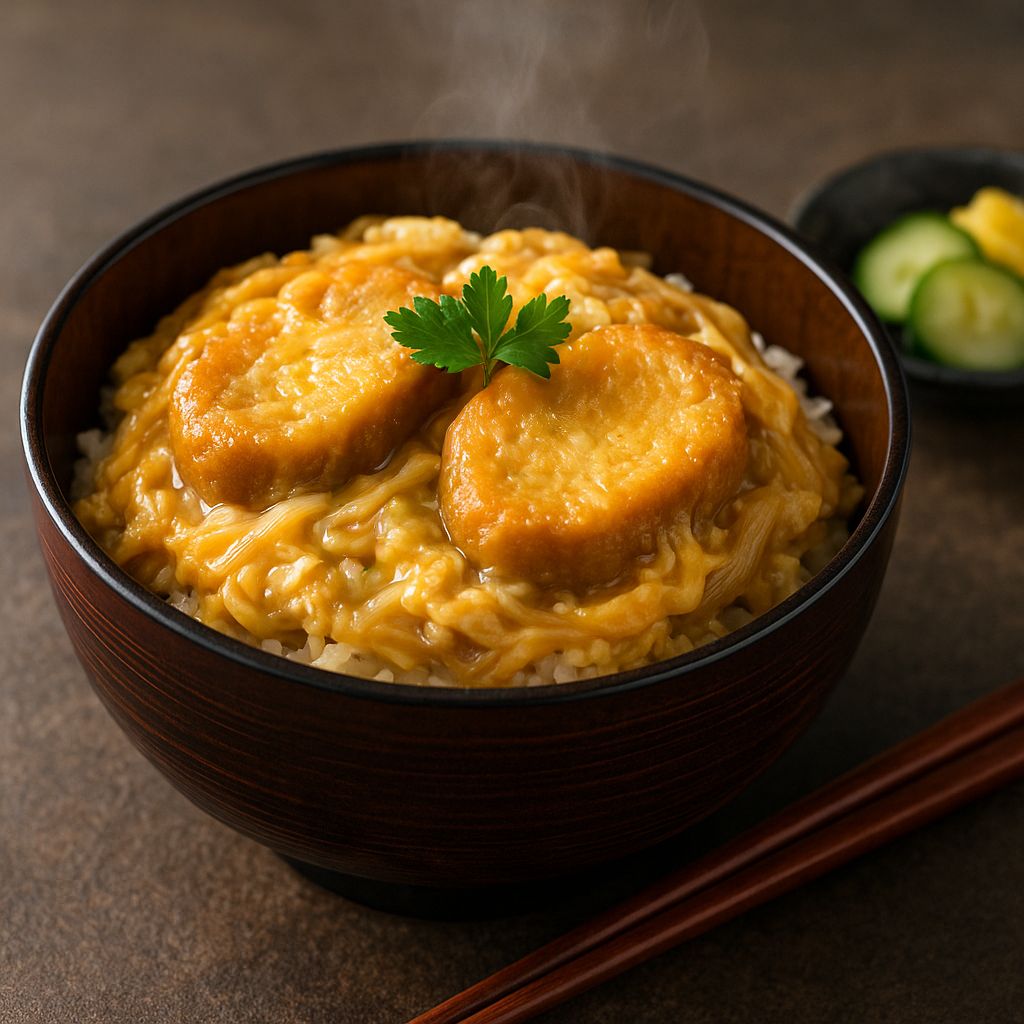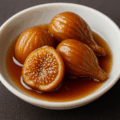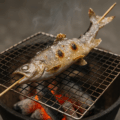油麩丼の特徴
出汁を吸ったあぶら麩のふくよかな旨み
油で揚げた小麦グルテン「あぶら麩」を甘辛いだしで煮含め、卵でとじてご飯にのせる丼です。だしをたっぷり吸ったあぶら麩は、口の中でじゅわっと広がる旨みと独特の弾力が魅力です。
玉ねぎと卵でやさしい甘さに
玉ねぎの甘さと卵のまろやかさが合わさり、重たく見えて後味は軽やかに仕上がります。仕上げに三つ葉や青ねぎを添えると、香りが立って全体の輪郭が引き締まります。
油麩丼 レシピ
材料
- あぶら麩(輪切り・厚さ1.5cm) … 8〜10枚(60〜80g)
- 玉ねぎ(薄切り) … 1/2個(約150g)
- 卵 … 3個
- だし(昆布かつお・顆粒可) … 250ml
- 濃口しょうゆ … 大さじ2
- みりん … 大さじ2
- 酒 … 大さじ1
- 砂糖 … 大さじ1
- 三つ葉または青ねぎ … 適量
- ご飯 … 丼2杯(約400g)
- 下処理用:熱湯 … 適量
作り方
- あぶら麩に熱湯を回しかけて余分な油を落とし、水気を軽く押して切る。
- 卵を溶きほぐす。玉ねぎは薄切りにする。
- 小鍋にだし・しょうゆ・みりん・酒・砂糖を入れて煮立て、玉ねぎを加えてしんなりするまで煮る。
- あぶら麩を加えて2〜3分煮含め、だしをしっかり吸わせる。
- 溶き卵の半量を回し入れ、半熟になったら残りを加え、火を止めて30〜60秒蒸らす。
- 丼にご飯をよそい、煮汁ごと具をのせ、三つ葉または青ねぎを散らす。
シェフのワンポイントアドバイス
- あぶら麩は熱湯で下処理すると油っぽさが抜け、だしの含みが良くなります。
- 卵は二度入れにすると、ふんわり感ととろみの両立ができます。
- だしを吸いすぎた場合は少量のだしを継ぎ足して温度を整えると、仕上がりが均一になります。
栄養価(1人分の目安)
- エネルギー … 約650kcal
- たんぱく質 … 約20g
- 脂質 … 約20g
- 炭水化物 … 約95g
- 食塩相当量 … 約3.0g
歴史
宮城北部で育まれたあぶら麩文化
宮城県北部では保存性と食べ応えを備えたあぶら麩が日常食として親しまれ、煮物や汁物に幅広く使われてきました。丼仕立ては家庭の定番として広がりました。
出前・学食・惣菜へと広がる人気
短時間で作れて冷めても味が落ちにくいことから、食堂や惣菜としても定着しました。玉ねぎと卵の組み合わせが幅広い世代に好まれています。
精進料理の知恵が生んだ“肉代わり”の満足感
肉を用いない精進の工夫として、あぶら麩がたんぱく源・食感の要として活躍してきました。その流れが丼物にも受け継がれています。
English Version
Features of Abura-fu Donburi (Miyagi)
Juicy wheat-gluten “abura-fu” that drinks up the broth
Deep-fried wheat gluten (abura-fu) is simmered in a sweet-savory dashi and set with eggs over rice. Once soaked, the rings release a burst of umami with a pleasantly springy bite.
Onion and egg for a gentle, light finish
Sweet onions and velvety eggs round the flavors without heaviness. A scatter of mitsuba or scallions lifts the aroma and sharpens the overall balance.
Recipe – Abura-fu Donburi (Miyagi)
Ingredients (Serves 2)
- Abura-fu, sliced in 1.5 cm rings … 8–10 pieces (60–80 g)
- Onion, thinly sliced … 1/2 (about 150 g)
- Eggs … 3
- Dashi (kombu–bonito or granules) … 250 ml
- Soy sauce (koikuchi) … 2 Tbsp
- Mirin … 2 Tbsp
- Sake … 1 Tbsp
- Sugar … 1 Tbsp
- Mitsuba or scallions … to finish
- Cooked rice … 2 bowls (about 400 g)
- For prepping: boiling water … as needed
Directions
- Rinse abura-fu with boiling water to remove excess oil; press gently to drain.
- Beat the eggs; slice the onion thinly.
- Bring dashi, soy sauce, mirin, sake, and sugar to a boil; add onion and simmer until tender.
- Add abura-fu and simmer 2–3 minutes so it absorbs the broth.
- Pour in half the beaten eggs; when softly set, add the rest. Turn off the heat and steam 30–60 seconds.
- Spoon rice into bowls, slide the topping with sauce over, and finish with mitsuba or scallions.
Chef’s Tips
- Hot-water rinse improves absorption and removes greasiness from abura-fu.
- A stable base: dashi : soy : mirin ≈ 10 : 1 : 1; adjust sweetness with sugar.
- Two-stage egg addition gives both fluff and gentle custardy texture.
- If the broth gets over-absorbed, add a splash of dashi to rebalance and keep temperature even.
Nutrition (per serving, approx.)
- Energy … ~650 kcal
- Protein … ~20 g
- Fat … ~20 g
- Carbohydrates … ~95 g
- Salt equivalent … ~3.0 g
History
Abura-fu culture in northern Miyagi
In northern Miyagi, abura-fu has long been a pantry staple valued for keeping quality and satisfying bite. It found its way into simmered dishes, soups, and, eventually, rice bowls.
From home kitchens to diners and deli counters
Quick to make and resilient after cooling, the dish spread to canteens and deli cases. The onion-and-egg pairing appeals across generations.
Satisfying “meatless” know-how from temple cuisine
As a protein stand-in with chewy texture, abura-fu reflects the ingenuity of meat-free cooking traditions—an idea that naturally evolved into this donburi style.



何でも質問してください!